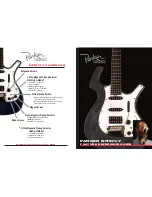
29
29
Note: Cut the groove for the “purfling” on the TOP ONLY!!!
5)
Install the 1” rabbeting bit in a small laminate router to match the
width and
depth
of the
purfling.
Set the height just slightly shallower
than the height of the purfling. Go all the way around the body and
cut the groove.
Important Note:
Remember to change to a lower depth of cut for the
purfling.
If not you will have made an irreversible cut.
Note:
Use the following setups for the number of purfling strips
a.
.48 – Six Pieces of purfling
b.
.64 – Five Pieces of purfling
c.
.70 – Four pieces of purfling
6)
Scrape one side of the binding to ensure that the glued side is smooth.
Note:
The binding has a thin contrasting strip that must be scraped flush on
the side that will be glued in the groove. Otherwise, the binding will not sit
in the groove properly. If the thin strip is separated from the wider binding
strip, don’t worry about scraping this area. When you glue the binding on,
the glue will re-adhere this spot.
Note:
All the layers of the “purfling” are attached to one another on one end.
Before trying to glue all of the layers of the “purfling” and the binding for
the top at the same time, unravel the “purfling” layers and run them through
your fingertips tape them to a flat board or let them hang freely for a day or
two to “relax”.
7)
Make a clean 90 degree angle cut on one
end of the binding. Get your Duco
cement, binding, and blue tape close by.
Starting at the top, middle of the back,
begin by sparingly applying glue into
about 3” of the rabbet. Fit the binding
into the channel then tape it firmly in
place. Continue gluing & taping until you
go all the way around the guitar. Don’t stretch the binding. Take a
few of those big rubber bands (if you have them) and stretch them
around the waist (narrow part) of the body. If you do not have rubber
bands, use plenty of blue tape at the waist of the guitar. Check for any














































